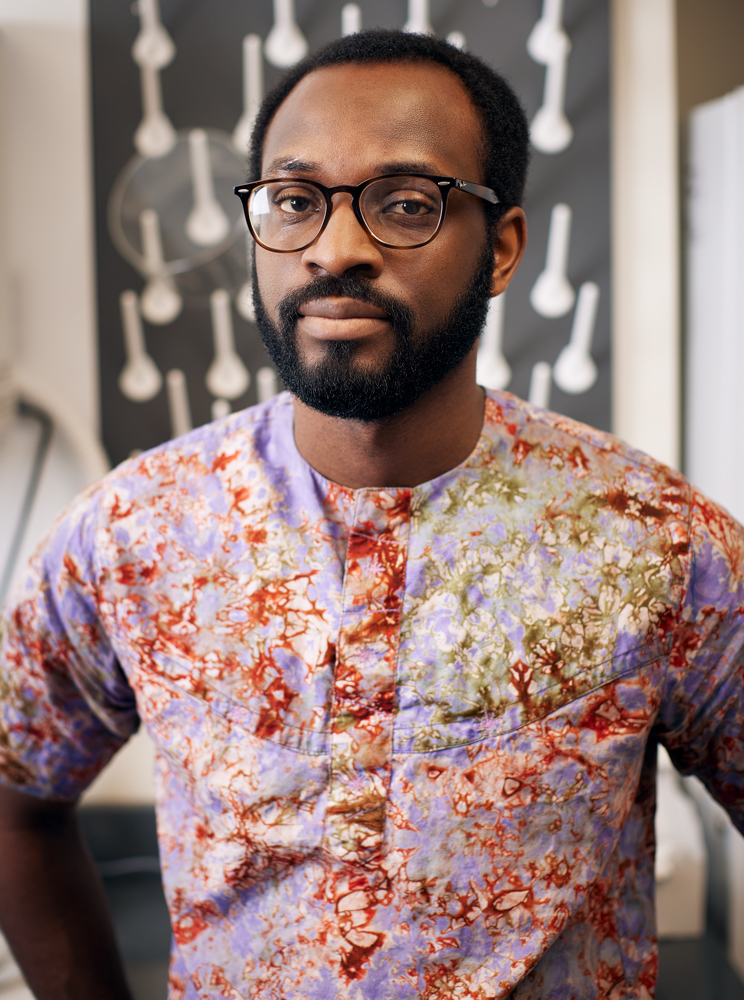NURTURING A RESILIENT EARTH
Tackling the carbon-conversion problem
By: Liz Do & Alison Rutka
24 Oct, 2023
The effects of climate change can be felt globally at an alarming rate. CIFAR is at the forefront of addressing it. This special series, Nurturing a Resilient Earth, takes a closer look at how CIFAR’s community — across borders, roles and disciplines — is making a meaningful impact to bring about powerful change.
Learn how CIFAR researcher Chibueze Amanchukwu is turning the carbon problem into a solution.
Want to learn more about their research?
Want to learn more about their research?
Watch: CIFAR Talks: Nurturing a Resilient Earth featuring researchers from the series.

Photo by Saverio Truglia
Rising carbon emissions across the planet are a key challenge to the climate crisis. In 2022, the world’s population emitted 36.8 billion tonnes of CO2 — 321 million tonnes more than the previous year.
According to the International Energy Agency, the pathway towards net-zero in 2050 is narrow, and requires an unprecedented shift in how energy is produced. Carbon capture and conversion is currently not an economically viable alternative to fossil fuel, however this technology is a key component to lowering worldwide emissions.
That is why researchers like Chibueze Amanchukwu — a CIFAR Azrieli Global Scholar in the Accelerated Decarbonization program — are also looking to carbon for climate change solutions. For Amanchukwu, he wants to find improved electrochemical methods to convert undesired and harmful CO2 into commercially valuable products, such as ethylene.
“Ethylene, a precursor to the production of many plastics and consumer goods, is the most ubiquitous industrial organic chemical in the world,” says Amanchukwu.
Amanchukwu and his group combine CO2, H2O and electrons to electrochemically convert CO2. The electrochemical process of carbon conversion takes place in a device called an electrolyzer. On the surface of a solid catalyst, CO2 is dissolved in liquid electrolyte, absorbs the electron, and can be transformed to ethylene and other products.
Unfortunately, several challenges plague the electrochemical conversion of CO2. For starters, it takes a significant amount of energy to convert CO2; researchers continue to improve the process to optimize and scale up the technology.
Amanchukwu’s work primarily focuses on understanding electrolyte design strategies, investigating how electrolyte selection can modify and improve the electrochemical reaction that takes place, and selectively control the desired product that forms — advancements that can raise value for carbon capture and conversion.
“To address rising CO2 emissions, the main goal is always to reduce the emissions at the source,” he notes. “But to make a dent in the climate change challenge, we also need different approaches. We need to be able to decarbonize and explore carbon capture and conversion.”
Figuring out how to scale CO2 capture and conversion remains a top priority for Amanchukwu. But to do it, he’ll need to address some questions of fundamental science. To date, no one knows what the best material to allow for carbon capture and conversion would be. While Amanchukwu and his team continue to run trials on various compounds that show promise, he acknowledges that collaboration will be necessary to realize the fundamental impact of his work.
In addition to working with partners and agencies, collaboration means leveraging the knowledge of his CIFAR peers in the Accelerated Decarbonization program, who come from a variety of disciplines. Since becoming a CIFAR Azrieli Global Scholar in 2022, he has been actively engaged with fellows of his program and other Global Scholars, allowing him to hear different perspectives on the carbon-conversion problem.
“CIFAR has allowed me to join an amazing network and to meet world-class scientists who are at the forefront of tackling climate change challenges from different perspectives. These perspectives help mold the type of work I focus on and have provided broader context to the work I do,” he says. “I am exposed to both big picture ideas as well as granular scientific approaches. It’s incredible to have access to a community of scholars thinking about this specific problem; CIFAR has given us this very rare opportunity.”
As Amanchukwu continues to improve methods for carbon conversion, a motivating factor for his work is his home country of Nigeria — he wants to ensure that when carbon conversion is scaled up, this technology is equitable for all.
“I want to make sure that the technologies that we develop are cheap enough to ensure that people don't get left behind,” he says. “People in Nigeria, for example, are trying to get to a level of comfort that we enjoy in the U.S. and Canada. How do we ensure that they have electricity products — in a renewable manner — that do not deny them the pleasures that we enjoy in the West? That's really a big part of the motivation for why I do what I do.”
How does CIFAR help you do impactful work to address climate change?
“CIFAR has allowed me to join an amazing network and to meet world-class scientists who are at the forefront of tackling climate change challenges from different perspectives. These perspectives help mold the type of work I focus on and have provided broader context to the work I do.”